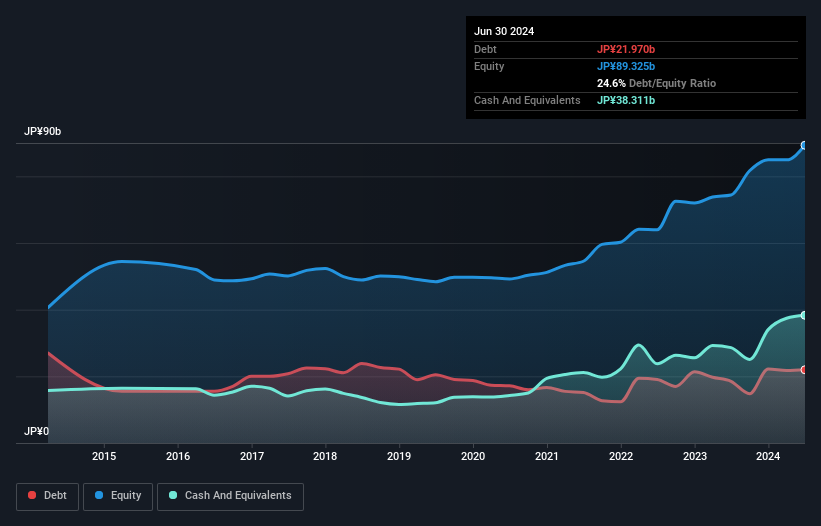- Japan
- /
- Electronic Equipment and Components
- /
- TSE:4980
We Think Dexerials (TSE:4980) Can Manage Its Debt With Ease
Howard Marks put it nicely when he said that, rather than worrying about share price volatility, 'The possibility of permanent loss is the risk I worry about... and every practical investor I know worries about.' When we think about how risky a company is, we always like to look at its use of debt, since debt overload can lead to ruin. We note that Dexerials Corporation (TSE:4980) does have debt on its balance sheet. But the more important question is: how much risk is that debt creating?
What Risk Does Debt Bring?
Generally speaking, debt only becomes a real problem when a company can't easily pay it off, either by raising capital or with its own cash flow. In the worst case scenario, a company can go bankrupt if it cannot pay its creditors. While that is not too common, we often do see indebted companies permanently diluting shareholders because lenders force them to raise capital at a distressed price. Of course, debt can be an important tool in businesses, particularly capital heavy businesses. When we think about a company's use of debt, we first look at cash and debt together.
Check out our latest analysis for Dexerials
How Much Debt Does Dexerials Carry?
As you can see below, at the end of June 2024, Dexerials had JP¥22.0b of debt, up from JP¥18.5b a year ago. Click the image for more detail. But it also has JP¥38.3b in cash to offset that, meaning it has JP¥16.3b net cash.

A Look At Dexerials' Liabilities
Zooming in on the latest balance sheet data, we can see that Dexerials had liabilities of JP¥31.1b due within 12 months and liabilities of JP¥20.3b due beyond that. Offsetting these obligations, it had cash of JP¥38.3b as well as receivables valued at JP¥17.1b due within 12 months. So it actually has JP¥3.93b more liquid assets than total liabilities.
Having regard to Dexerials' size, it seems that its liquid assets are well balanced with its total liabilities. So while it's hard to imagine that the JP¥396.4b company is struggling for cash, we still think it's worth monitoring its balance sheet. Simply put, the fact that Dexerials has more cash than debt is arguably a good indication that it can manage its debt safely.
On top of that, Dexerials grew its EBIT by 31% over the last twelve months, and that growth will make it easier to handle its debt. The balance sheet is clearly the area to focus on when you are analysing debt. But ultimately the future profitability of the business will decide if Dexerials can strengthen its balance sheet over time. So if you're focused on the future you can check out this free report showing analyst profit forecasts.
Finally, while the tax-man may adore accounting profits, lenders only accept cold hard cash. Dexerials may have net cash on the balance sheet, but it is still interesting to look at how well the business converts its earnings before interest and tax (EBIT) to free cash flow, because that will influence both its need for, and its capacity to manage debt. In the last three years, Dexerials's free cash flow amounted to 47% of its EBIT, less than we'd expect. That's not great, when it comes to paying down debt.
Summing Up
While it is always sensible to investigate a company's debt, in this case Dexerials has JP¥16.3b in net cash and a decent-looking balance sheet. And we liked the look of last year's 31% year-on-year EBIT growth. So is Dexerials's debt a risk? It doesn't seem so to us. When analysing debt levels, the balance sheet is the obvious place to start. However, not all investment risk resides within the balance sheet - far from it. These risks can be hard to spot. Every company has them, and we've spotted 3 warning signs for Dexerials you should know about.
If you're interested in investing in businesses that can grow profits without the burden of debt, then check out this free list of growing businesses that have net cash on the balance sheet.
New: Manage All Your Stock Portfolios in One Place
We've created the ultimate portfolio companion for stock investors, and it's free.
• Connect an unlimited number of Portfolios and see your total in one currency
• Be alerted to new Warning Signs or Risks via email or mobile
• Track the Fair Value of your stocks
Have feedback on this article? Concerned about the content? Get in touch with us directly. Alternatively, email editorial-team (at) simplywallst.com.
This article by Simply Wall St is general in nature. We provide commentary based on historical data and analyst forecasts only using an unbiased methodology and our articles are not intended to be financial advice. It does not constitute a recommendation to buy or sell any stock, and does not take account of your objectives, or your financial situation. We aim to bring you long-term focused analysis driven by fundamental data. Note that our analysis may not factor in the latest price-sensitive company announcements or qualitative material. Simply Wall St has no position in any stocks mentioned.
About TSE:4980
Dexerials
Manufactures and sells electronic components, bonding materials, optics materials, and other products in Japan.
Flawless balance sheet with reasonable growth potential.
Similar Companies
Market Insights
Community Narratives



